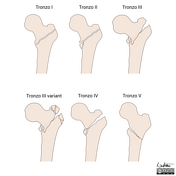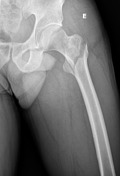Tronzo classification of trochanteric fractures
Disclosures
- updated 19 Aug 2022:
Nothing to disclose
Updates to Article Attributes
Body
was changed:
The Tronzo classification of trochanteric fractures is a classification system used when assessing intertrochanteric fractures.
The Tronzo classification is proposed to provide a guide to the management of these fractures.
Due to its simplicity, the Tronzo classification has become the preferred classification system by many institutions. However, many studies have shown the Tronzo classification has only poor inter and intraobserver reproducibility 1-3.
Classification
- type I: incomplete fracture
- type II: no posteromedial comminution, lesser trochanter may be fractured
- type III: posteromedial comminution, the shaft is medially displaced with the neck beak impacted into it
- type III variant: type III combined with greater trochanter fracture
- type IV: posteromedial comminution, the shaft is laterally displaced
- type V: reverse obliquity
See also
-<p>The <strong>Tronzo classification of trochanteric fractures</strong> is a classification system used when assessing <a href="/articles/trochanteric-fracture">intertrochanteric fractures</a>.</p><p>The Tronzo classification is proposed to provide a guide to the management of these fractures.</p><p>Due to its simplicity, the Tronzo classification has become the preferred classification system by many institutions. However, many studies have shown the Tronzo classification has only poor inter and intraobserver reproducibility <sup>1-3</sup>.</p><h4>Classification</h4><ul>-<li>-<strong>type I: </strong>incomplete fracture</li>-<li>-<strong>type II:</strong> no posteromedial comminution, lesser trochanter may be fractured</li>-<li>-<strong>type III:</strong> posteromedial comminution, the shaft is medially displaced with the neck beak impacted into it</li>-<li>-<strong>type III variant: </strong>type III combined with greater trochanter fracture</li>-<li>-<strong>type IV:</strong> posteromedial comminution, the shaft is laterally displaced</li>-<li>-<strong>type V:</strong> reverse obliquity</li>-</ul><h4>See also</h4><ul>-<li><a href="/articles/proximal-femoral-fractures">proximal femoral fracture</a></li>-<li><a href="/articles/trochanteric-fracture">trochanteric fracture</a></li>- +<p>The <strong>Tronzo classification of trochanteric fractures</strong> is a classification system used when assessing <a href="/articles/trochanteric-fracture">intertrochanteric fractures</a>.</p><p>The Tronzo classification is proposed to provide a guide to the management of these fractures.</p><p>Due to its simplicity, the Tronzo classification has become the preferred classification system by many institutions. However, many studies have shown the Tronzo classification has only poor inter and intraobserver reproducibility <sup>1-3</sup>.</p><h4>Classification</h4><ul>
- +<li>
- +<strong>type I: </strong>incomplete fracture</li>
- +<li>
- +<strong>type II:</strong> no posteromedial comminution, lesser trochanter may be fractured</li>
- +<li>
- +<strong>type III:</strong> posteromedial comminution, the shaft is medially displaced with the neck beak impacted into it</li>
- +<li>
- +<strong>type III variant: </strong>type III combined with greater trochanter fracture</li>
- +<li>
- +<strong>type IV:</strong> posteromedial comminution, the shaft is laterally displaced</li>
- +<li>
- +<strong>type V:</strong> reverse obliquity</li>
- +</ul><h4>See also</h4><ul>
- +<li><a href="/articles/proximal-femoral-fractures">proximal femoral fracture</a></li>
- +<li><a href="/articles/trochanteric-fracture">trochanteric fracture</a></li>
Images Changes:
Image 1 Diagram (Tronzo classification (white)) ( destroy )

Ddx
was removed.
Caption
was removed:
Position
was removed.
Image 1 Diagram (Tronzo classification) ( create )

Caption
was added:
Figure 1
Position
was set to
1.
Image 2 X-ray (Frontal) ( update )

Position
changed from 2 to 3.
Image 3 X-ray (Frontal) ( update )

Position
changed from 3 to 4.







 Unable to process the form. Check for errors and try again.
Unable to process the form. Check for errors and try again.